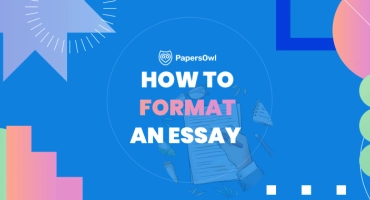How to Write References and Cite Sources in a Research Paper?
Table of contents
Citation is necessary while writing your school essay, a publication, or a Master’s thesis. We all want our efforts to be acknowledged, right? The lack of references and citations can make the source think you are trying to steal their work. Hence, the question is how to go about making references. Is just putting quotation marks enough? What should you do to not look like a stealer of ideas?
Do you want to know how to complete a citation for your research paper writer services and research paper? Then this article is for you, as it contains the details of how to reference when writing a research paper for university or scientific work!
There is a standard way to do this in educational journals and organizational publications. Crediting the sources is crucial in any type of academic work. You need to know additional information, actually. But no worries! Professional research paper writing service PapersOwl will be your lighthouse on this topic!
Hence, a researcher must understand how to reference their writings, research papers, or journals. It is another thing to write a journal properly, but crediting the cited sources is more crucial.
Follow this guide to learn:
- How to cite a research paper?
- The importance of referencing and citations for your academic works;
- How to cite in APA, MLA, Chicago, IEEE, and ASA formats;
- How to create a bibliography for your paper;
- Essential guidelines to follow for a published work.
Choosing the Right Citation Style
Now that the advantages have been established, the new worry is the choice of the right style. There are several styles for research papers and their respective peculiarities. For example, the MLA writing style is common in liberal scientific paper citations. Let’s delve more into the topic!
APA Format (American Psychological Association)
The commonest style many scholars use is APA formatting, especially if no stated style exists. This approach employs the use of in-text citations to explain the source:
“Exercise is a good way to recover from ailments.” APA style, n.d. (American Psychological Association).”
The reference style includes:
- The author’s name;
- The author’s name is in parenthesis to follow the referenced excerpt;
- The publication date.
MLA (Modern Language Association)
MLA-style formation is concise and known for its scientific referencing format. The peculiarity of the MLA citation is its source citation, episode name, and document layout. You have to:
- Include the parenthetical citation;
- Create some spaces away from the left margin;
- Include the author’s or source’s name.
Ensure you capitalize every word when including the names. You can employ professional MLA Citation Generators to make the compilation easier. It is perfect for the citation format of scientific papers.
Chicago Style
Chicago’s style is famous for two things:
- The in-text citation within the paper;
- The reference list is at its end.
It is an author-date approach. Hence, the in-text citation for a research paper has the author’s or source name and publication year.
IEEE (Institute of Electrical and Electronics Engineers)
This employs the use of numbers. It is chronological as it arranges the citation based on the order of appearance. A click on it takes the reader to the full reference at the end of the paper. You can employ IEEE Citation Maker to make a well-curated task easier. This way, you won’t have to worry about the manual compilation of the IEEE citation style.
ASA
This is similar to the author-date approach by Chicago Style. You can:
- Create the quotation;
- Include the parentheses for the author’s name and publication date;
- Add the page number using a colon.
In-Text Citations
In-text citations provide brief information about a source within the content, typically including the author’s last name and the publication year. This helps readers locate full details in the reference list. Below are examples of in-text citations for different styles:
- APA style: (Smith, 2021)
- MLA: (Smith 45)
- Chicago: (Smith 2021, 45)
- IEEE: [1]
Each format has unique requirements, but these examples show the basic structure for each style.
How to Cite Direct Quotations Across Citation Styles?
The general rule for citing direct quotations is that every in-text citation must have a corresponding entry in your reference list. In all styles, quotations should include the author’s name, publication year (if applicable), and page number.
For instance, across APA, MLA, and Chicago formats, a direct quote would look similar to:
“Social institutions shape our behaviors and interactions profoundly” (Smith, 2010, p. 45).
In IEEE style, this same quote would be cited with a numerical reference in brackets, like this:
“Social institutions shape our behaviors and interactions profoundly” [1].
While each citation style has its unique format, following these general guidelines will ensure accurate attribution for direct quotations. For specific formatting rules, consult the guidelines for APA, MLA Style formatting, Chicago, or IEEE as required.
How to Cite Paraphrased Information?
When paraphrasing in a research paper, it’s essential to credit the original source. All citation styles use parenthetical citations to reference paraphrased information, usually including the author’s name and year of publication. For instance:
“Strength can be defined in terms of ability and acquired skills (Jack et al., 2023).”
Citing Multiple Authors & Group Authors
List all names for the first citation when citing a work with multiple authors. For subsequent references, include only the first author’s surname followed by “et al.” Such as, to generate a citation in APA for three authors, the first in-text citation might appear as (Smith, Johnson, & Lee, 2018), while later citations could be shortened to (Smith et al., 2018).
For group or organization authors, use the full name initially and an abbreviation in subsequent mentions, such as (American Psychological Association [APA format], 2019), followed by (APA, 2019) for later references.
Creating a Reference List or Bibliography
One of the essential tips for writing a research paper is creating a well-organized reference list or bibliography. Start by formatting your references consistently, listing each source used in the text. Arrange entries alphabetically or numerically by author’s last name, depending on the citation style. Include essential details like author, name of work, year of publication, and page numbers to ensure clarity and accuracy. Following these steps will help maintain a professional and readable bibliography.
Each source type ─ books, journal articles, chapters, literature reviews, conference papers, or online sources ─ follows a specific format in various citation formats. Below are streamlined instances for each.
- Book
- APA style: Author, Initial. (Year of publication). Book Title. City, Country: Publisher.
- Example: Social, M. (2023). The effect of the internet in this modern era. London, England: Ink.
- MLA: Author Last Name, First Name. Book Title: Subtitle. Edition, Publisher, Year.
- Example: Donaldson, Bruce. Dutch: A Comprehensive Grammar. 3rd ed., Routledge, 2017.
- Chicago: Author Last Name, First Name. Book Title: Subtitle. Edition. City: Publisher, Year.
- Example: Angelou, Maya. I Know Why the Caged Bird Sings. 1st ed. New York: Random House, 1969.
- APA style: Author, Initial. (Year of publication). Book Title. City, Country: Publisher.
- Academic Journal Article / Articles
- APA: Author, Initial. (Year of publication). Journal Article Title. Journal Title, Volume (Issue), Page range. URL
- Example: Social, M. (2023). The effect of the internet. Digital Technology, 26(8), 22-24. (Insert URL).
- MLA: Author. “Journal Article Title.” Journal Title, vol. Volume, no. Issue, Year, Page range. DOI
- Example: Ahmed, Sara. “What is Whiteness.” Feminist Theory, vol. 8, no. 2, 2007, pp. 149–168. https://doi.org/10.1177/1464700107078139
- Chicago: Author Last Name, First Name. “Article Title.” Journal Name Volume, No. Issue (Year): Page range. DOI or URL.
- Example: Pickard, Hanna. “What Is Personality Disorder?” Philosophy, Psychiatry, & Psychology 18, no. 3 (2011): 181–84. https://doi.org/10.1353/ppp.2011.0040.
- APA: Author, Initial. (Year of publication). Journal Article Title. Journal Title, Volume (Issue), Page range. URL
- Chapter in an Edited Book
- APA: Author, Initial. (Year). Chapter Title. In Editor Initial Last Name (Ed.), Book Title(pp. Page range). City, Country: Publisher.
- Example: Social, M. (2023). Coarctation. In D.S. Moodie (Ed.), Management of heart disease (pp. 142-170). Minneapolis, MN: Cardiotext Publishing.
- MLA: Author Last Name, First Name. “Chapter Title.” Book Title, edited by Editor Name, Publisher, Year, Page range.
- Example: Schwartz, Paula. “Redefining Resistance.” Behind the Lines, Yale UP, 1987, pp. 141–53.
- Chicago: Author Last Name, First Name. “Chapter Title.” In Book Title, edited by Editor Name, Page range. City: Publisher, Year.
- Example: Nussbaum, Martha. “Legal Reasoning.” In The Cambridge Law, edited by John Tasioulas, 59–77. Cambridge: Cambridge UP, 2020.
- APA: Author, Initial. (Year). Chapter Title. In Editor Initial Last Name (Ed.), Book Title(pp. Page range). City, Country: Publisher.
- Conference Paper
- APA: Author, Initial. (Year). Paper Title. In Editor Initial Last Name (Ed.),Proceedings Title. City: Publisher.
- Example: Winstone, N., & Boud, D. (2017). Supporting students’ engagement. Annual Conference, Newport, South Wales.
- MLA: Author Last Name, First Name. “Paper Title.” Proceedings Title, Conference Location, Date, Publisher, Year.
- Example: Lewis, Jack. “Literature: The Consequences of Loss.” Library Proceedings Conference, Amsterdam, 2015.
- APA: Author, Initial. (Year). Paper Title. In Editor Initial Last Name (Ed.),Proceedings Title. City: Publisher.
- Online Source
- APA: Last Name, Initials. (Year, Month Day). Title. Site Name. URL
- Example: The countdown: A prophecy takedown. (2020, October 19). BBC News. https://www.bbc.com/news/election-us-2020-54596667.
- MLA: Author Last Name, First Name. Title. Who Published, Year. URL
- Example: Smith, Thomas. The Citation Manual. Wiley, 2020.
- APA: Last Name, Initials. (Year, Month Day). Title. Site Name. URL
Leave No Stone Unturned!
Proper referencing and citation are more than just quotation marks. Citing is vital for preserving the relevance of your academic paper. By citing sources accurately, your research gains the credibility it needs to stand the test of time. This careful documentation allows future scholars and students to refer to your work even as new advancements emerge. A well-cited work remains evergreen, continually contributing to academic discourse.
Following the correct citation format is essential to giving credit in crafting a research paper! Common styles include APA, MLA, Chicago, IEEE, and ASA, each with specific guidelines for citing sources. If no specific style is specified, APA guidelines are generally recommended, as this format is widely accepted. From formatting title pages and page numbers to organizing a “Works Cited” page and correctly applying title case or sentence case, attention to detail in referencing enhances the professionalism of your document.
Whether you’re referencing any web address, works cited like articles, or other original sources, using the right credit format safeguards your work against plagiarism, robs ideas, and ensures clarity for readers. By adhering to these conventions, you elevate the quality of your writing and contribute to the academic community of your university or, in general, with confidence!







